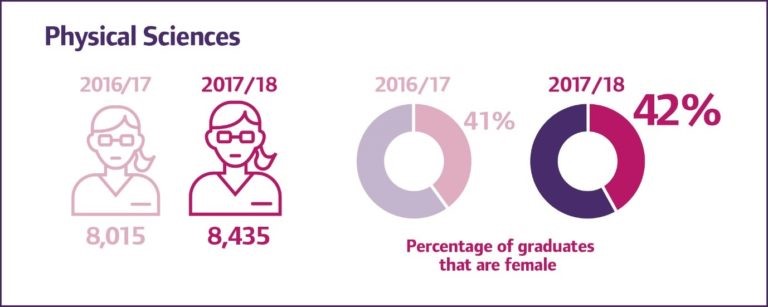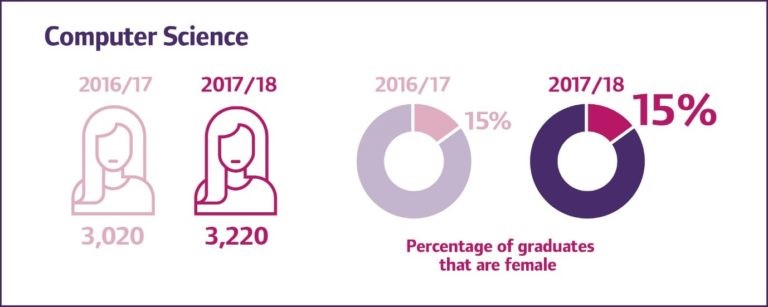Introduction
The number of core-STEM female higher education qualification achievements (Levels 4-6 – henceforth referred to as ‘graduates’ for simplicity) increased between 2018 and 2019, continuing the trend of recent years. However, the percentage of core-STEM graduates who are female has stalled at 26%, as the number of male achievements has also increased.
The increase in the number of female core-STEM graduates between 2018-9 was smaller than the increase between 2017-8.

The percentage of female graduates who get a core-STEM qualification has remained at 9%, as it was in 2018. By way of comparison, 33% of males who got a higher education qualification in 2019 graduated in a core-STEM subject.

Physical Sciences
There has been a year-on-year drop in the number of women getting higher education qualifications in physical sciences. However, a drop in the number of males means that the percentage of physical sciences graduates who are female has actually increased, from 42% in 2018 to 43% in 2019.

Mathematical Sciences
There has been a year-on-year drop in the number of female graduates in mathematical sciences, which has also led to the percentage dropping.
Between 2015 and 2016 the number of maths A Levels being awarded to females dropped, so it is likely that this is being mirrored in the drop in female mathematical sciences graduates between 2018 and 2019 (assuming a three year undergraduate degree). The number of maths A Levels achieved by females increased significantly between 2016 and 2017 (by over 2,000) so it’s possible that the figures for 2020 mathematical sciences graduates will be more positive.

Computer Science
The number of females graduating in computer science has, once again, increased year-on-year. The percentage of computer science higher education qualifications going to females has also increased to 16%, having stalled the previous year.

Engineering & Technology
The increase in the number of females achieving higher education qualifications in engineering-related subject areas is welcome, and it has led to an increase in the female percentage after it stalled last year (2017-8 academic year).

Architecture, Building & Planning
The increase in the number of females achieving higher education qualifications in architecture-related disciplines means the percentage has increased to 37%, continuing the trend of recent years

Postgraduate
For the first time, our analysis this year covers postgraduate qualifications. There are some interesting differences between undergraduate and postgraduate core-STEM qualifications where gender split is concerned.
In the 2018/9 academic year, in four out of five subject areas the percentage of core-STEM postgraduate qualifications being awarded to females was higher than the percentage of core-STEM undergraduate qualifications being awarded to females (mathematical sciences being the exception).
This means that the percentage of postgraduate core-STEM qualifications going to females, at 35% overall, is significantly higher than the percentage of undergraduate core-STEM qualifications, at 26%.

Note: A full list of what’s included in each subject area can be found at the Ucas website. Analysis based on HESA data.
